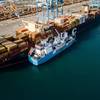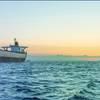Unsafe mixed migration by sea continues to claim many lives, despite the strenuous efforts made by Governmental and naval rescue services, often supported by merchant vessels, abiding by the long-standing tradition and legal obligation to go to the rescue of persons in distress at sea.
The complexities of this humanitarian challenge were discussed on Monday (30 October) at a meeting hosted by the International Maritime Organization (IMO), bringing together representatives of UN agencies, the maritime industry and European Union naval forces.
For the rescued and seafarers alike, the experience can be harrowing. A modern merchant vessel is unsuited to carrying large numbers of survivors, offering inadequate shelter, medical care or sanitation in such situations, and with limited spare food and water on board.
Three rescues involving merchant ships in the Mediterranean illustrate the challenges.
In October 2016, the fully-laden oil tanker Okyroe, with a crew of 21 seafarers on board, rescued 1,536 people from rubber dinghies; 778 were transferred to rescue vessels over a two-day period and 758 were transferred by the vessel to port of Augusta, Italy.
In August 2016, the platform supply vessel OOC Jaguar rescued 501 people from several rubber boats, including one just-delivered baby and her mother. A crew member unwrapped the umbilical chord from the baby’s neck and helped the mother deliver the placenta.
In April 2016, the container ship Hamburg Bridge rescued 310 people who had been crammed aboard one small boat.
Reports show that this year (up to 20 October), some 147,000 migrants and refugees entered Europe by sea. The majority arrived in Italy and the remainder were divided between Greece, Cyprus and Spain. But 2,826 individuals who attempted the journey, during the same time frame, lost their lives at sea. Although the number of deaths in the Mediterranean has seen a decline, year on year, the ratio of fatalities to attempted journeys is increasing.
Merchant vessels become involved in about one in ten rescue operations in the Mediterranean - 101 cases to date in 2017, and in 112 cases in 2016 - in the sea area covered by the Rome, Italy, Maritime Rescue Coordination Centre, the meeting was told.
While search and rescue operations continue, the meeting participants recognized that the systems established under IMO’s Convention for the Safety of Life at Sea (SOLAS) and the Search and Rescue (SAR) Convention were never envisaged as, or intended to be, a response to mass migration.
“Although governments and the merchant shipping industry will continue rescue operations, safe, legal, alternative pathways to migration must be developed, including safe, organized migration by sea, if necessary,” said IMO Secretary-General Kitack Lim.
The solutions to reducing the loss of life at sea were discussed. These include addressing “push” factors, tackling the criminal activity involved in people trafficking and enhanced collaboration amongst international agencies and States.
Attending the meeting were representatives from International Organization for Migration (IOM), the UN Refugee Agency (UNHCR), United Nations Human Rights (OHCHR), the United Nations Office on Drugs and Crime (UNODC), the European Union Naval Forces (EU NAVFOR), BIMCO, the International Chamber of Shipping (ICS), the International Federation of Shipmasters' Associations (IFSMA) and the International Transport Workers’ Federation (ITF).
The record of views of the meeting will be fed into the Global Compact on Migration, a UN Member State-led process that emanated from the 19 September 2016 New York Declaration for Refugees and Migrants approved by Heads of State during the UN General Assembly. This two-year long process is expected to culminate in the adoption of the GCM at an intergovernmental conference on international migration in 2018.






